One in three faces. Sergeant York's rifle
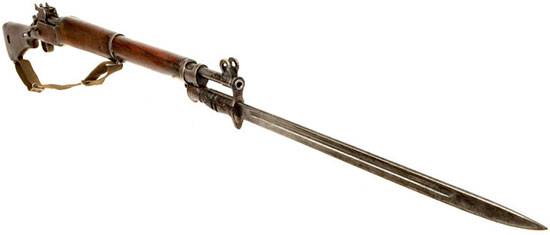
Now quite popular occupation is the compilation of various ratings, in particular - samples of military equipment. And although for the most part these ratings are rather subjective, however, this form of presenting information increases interest in it. And if among the rifle weapons the rating for the greatest number of names was made, then this rifle, undoubtedly, would apply for the highest places. However, if the rating was made by the amount of information - the opposite is true.
1. We will deal with the names.
At home in Britain, she was in service under the official name Enfield P14 or "Rifle, Magazine, .303, Pattern 1914" (rifle, magazine, caliber. 303, sample 1914 of the year), abbreviated "Pattern 1914" or simplified "P14" (sample 14). In 1926, the outdated rifle designation system in the British Army was modified, resulting in the Enfield P14 rifle being designated “Rifle No.3”.
The rifle served in the British army until the 1947 year, when it was declared obsolete and removed from service.
In the US, the rifle was in service with the Enfield M1917 United States Rifle, cal .30 or Eddiston 1917, or simply “Р17”. This is the same P14 rifle under the American unitary ammunition 7,62 × 63 mm. It was developed in 1917 year, took part in all major wars of the XX century up to the Vietnam War.
The British-made Ross-Enfield 1914 rifle is already Lithuania. Regarding how the name of the Canadian designer, famous traveler and hunter Charles Ross appeared in the name of the rifle, story does not give a clear answer. Back in 1900, Charles Ross designed the 7-mm single-shot rifle of his own system for his world tour, which had a very original direct-action shutter. The rifle withstood the two-year test during the sea travel Ross. In the 1907, the 5-charging magazine was designed for it, and as such it was adopted in Canada under the designation Ross Mod in 1910. 1910, and the “Ross Rifle Company” was established in Quebec to manufacture them. The cartridge used in the rifle, also began to be called by his name - .280 Ross. However, the Ross rifle in a constructive sense had practically nothing in common with the Ross-Enfield Mod rifle. 1914 (longitudinal sliding bolt of direct action (without turning when locking), single-row magazine protruding from the lodge, a different form of the receiver, etc.) The only similarity is dioptric sights of similar design. An article from the press organ of the Armed Forces of Lithuania - the newspaper "Kardas" ("The Sword") N19 for October 1925 g. Points at the sight
Newspaper "Kardas" ("Sword") N19 for October 1925
“The ross-enfield rifle of the 1914 model of the year is an enhanced Lee-Enfield rifle of the 1903 model of the year. In it, an inconvenient box-shaped store jutting out of the box was replaced by a store hidden in the box. In addition, the sights are completely redone, the so-called diopter sight is used. As a sample (from the original text it is not very clear what sample it is, the most likely is a diopter sight, or rather its type and location) the Canadian rifle of the Ross system was used, which gave the new name to the rifle. ” Under the same name, the rifle was in service with Estonia.
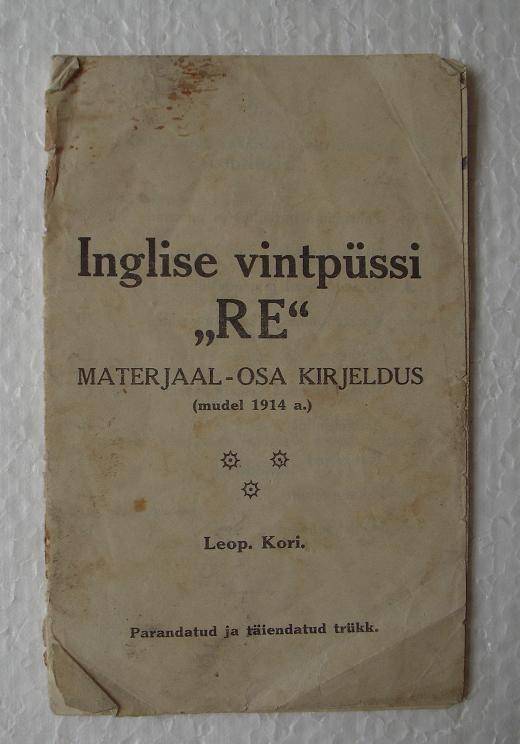
Ross-Enfield Rifle Service Manual of the Estonian Army
On the other hand, the company “Companies Ross rifles” in Quebec, Canada, started the production of this model of weapon, which could also affect the name of the rifle.
It should be noted that the name "Ross-Enfield" neither in Britain nor in the United States was not used. In any case, in such authoritative reference books as F. de Haas "Bolt Action Rifles", 3th Edition, DBI Books, Krause Publications, Inc., Vernon Hills, IL, 1995, 528 pp. (“Longitudinal Slide Rifles”) and G. Markham “Guns of the Empire. Firearms of the British Soldier, 1837-1987 »Agtzb-Agtoig Press, London, 1990 (British Army 1837-1987 handguns) rifle is designated Enfield P14 and Enfield M1917 respectively.
In the literature there is another name - "Enfield - Mauser". But more about that in the future.
2. History of creation.
In the late XIX - early XX centuries, one of the most well-known and respected arms firms was the German company Gebrüder Mauser & Co.. Most of the military, and not only the Germans, believed that the future of the weapons business was precisely behind rifles such as Mauser G98 and other similar developments. Similar thoughts were not an exception in the UK - many representatives of the British commanders believed that the adopted (and later famous) rifle Rifle, Short, Magazine, Lee-Enfield, or SMLE would not be able to withstand German weapons.
The popularity of Mauser rifles in the UK was very large. The reasons for this were as follows. The first reason lies in the sphere of civil. In Britain, which had extensive colonies, hunting was very popular. Great practical experience of the British in the operation of powerful hunting cartridges contributed to the popularization of the Mauser system.
It was a time when, along with double-barreled "nitroexpress", rifles Jeffrey, Rigby, Gibbs, Holland-Holland and other manufacturers of powerful piece weapons capable of dealing with any game, including the most dangerous animals of the Black Continent, became increasingly popular. The powerful “pincers” of the Mauser system extracted even a bullet in the chamber chamber (which was a frequent event in the hot African climate) and made it possible to make not one but two or three repeated shots at the attacking beast. At the same time, the presence of one barrel instead of two provided an increase in the accuracy of fire and the opportunity to get "in place" from the first shot.
The second reason - the experience of fighting. The rank and file of the British army, which participated in the second Anglo-Boer War (1899 - 1902), learned from their own experience that the enemy, armed with Mauser system rifles, the 1895 model of the year 7x57mm, fired at a less rapid, but more heap.
The main weapon of the British in this war - the Lee-Enfield magazine rifle - was originally put into service in 1895 and was a modernized version of the Li-Metford 7,69 model rifle 303-mm (.1888). The modernization was mainly to replace the trunk (Lee-Metford had a trunk with seven segment grooves, and Lee-Enfield had five deeper rectangular grooves). This became necessary because of the adoption of cartridges with smokeless powder (cordite): when firing, the sloping cuts of the Metford system wore out very quickly. Since the shooting from both rifles was carried out with cartridges of the same caliber, another caliber symbol, 7,71 mm, was used for the cartridges of the Lee Enfield rifle. The new rifle was equipped with a device for filling the magazine with cartridges using two clips.
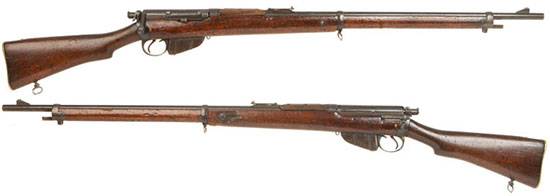
Rifle Magazine Lee-Enfield Mk I (MLE Mk I)
The flaws of the rifle were quickly taken into account and already in 1903, a new rifle was adopted, having a revolutionary concept for that time - “.303 caliber, Rifle, Short, Magazine, Lee-Enfield, Mark I” (abbreviated SMLE Mark I), There is a magazine rifle, short, Enfield system. The revolutionary idea was to create a rifle, intermediate in length between a short cavalry carbine and an infantry rifle, equally suitable for cavalry, and for infantry, and for other troops.
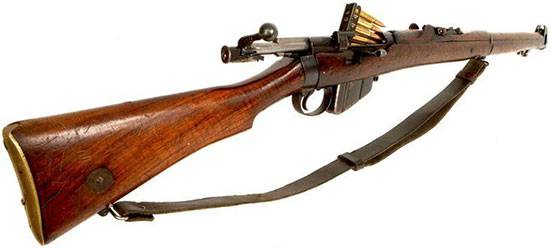
SMLE Mk I rifle
However, such a seemingly sound idea was met with hostility by a host of theorists from military affairs, who claimed that such a weapon would be equally bad for both infantry and cavalry. A typical example of such criticism is an excerpt from the magazine Arms and Explosives in November 1908: "The rifle was always bad, its flaws are well known, and more than one generation will criticize it." In a word, the British theorists demanded that the Boer Mauser, who significantly surpassed the British Lee-Metford and the Lee-Enfield in practical rate of fire and range of shooting, were considerably overpowered by the British theorists.
In addition, the production of the Lee-Enfield system showed that this system is hard to call "high-tech" - the receiver of the rifle, to which considerable efforts were made when firing, had a split jumper that did not add any rigidity to it. Therefore, the process of manufacturing a receiver of a given strength required a lot of material and labor costs.
All of the above ultimately led to the fact that in 1910, the military committee put before the British gunsmith engineers extremely simple and clear requirements: to create a "British Mauser" rifle, similar to Mauser G98, but calculated for a more powerful cartridge. The rifle should have absorbed all the advanced that world practice had accumulated by that time.
According to the requirements of the military committee, by the 1912, the royal arsenal of small arms “Royal Small Arms Factory” in the city of Enfield developed a new cartridge of the caliber 7 mm (.276) with a sleeve without edge.

Cartridge .276 Enfield
And by 1913, a magazine rifle was created for this munition, which received the designation “Rifle, Magazine, .276, Pattern 1913” (rifle, magazine, .276 caliber, sample 1913 of the year), abbreviated “Pattern 1913” or simply “P13” ( 13 sample.
The new weapon traced the features of two rifles - the German Mauser 1898 model of the year and the British Le Enfield SMLE 1904 of the year. It is from here that the roots of the name “Enfield - Mauser” found in literature. The basis of the device shutter, trigger and store this rifle was based on the Mauser system, reworked Enfield arsenal. The SMLE borrowed side sights and redesigned shape of the bed.
Enfield P13 was quite successful and accurate rifle, but there were problems with ammunition for it. The new .276 caliber cartridge proved to be very powerful and resulted in too much recoil and muzzle flash, deformation of some parts, pressure changes in the chamber, as well as rapid wear of the barrel.
But the British command did not leave the idea of arming the troops "analogue Mauser." Therefore, in the course of further design research, it was decided to use the standard .13 British cartridge (303x7.7 R), which had less power, as an ammunition for the Enfield P56 rifle. The weapon was prepared for serial production under the designation “Rifle, Magazine, .303, Pattern 1914” (rifle, magazine, caliber. 303, sample 1914 of the year), abbreviated “Pattern 1914” or simply “P14” (sample 14).
3. Design.
Structurally, the Enfield P14 (No.3) was a magazine rifle with manual reloading with a Mauser-type rotary sliding slide with two front stop lugs and a massive non-rotating ejector. One of the differences between the Enfield-Mauser shutter and the Mauser shutter was the presence in the front part of the shutter stem of two openings for removal of powder gases in case of their breakthrough.
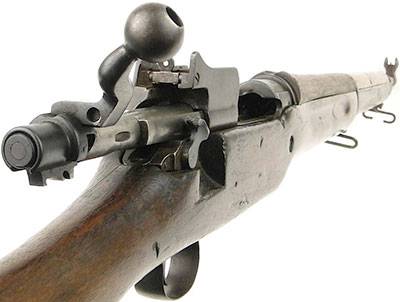
View of Enfield P14 Controls
The bolt almost completely copies the Mauser's bolt, except for the fuse, which Enfield-Mauser has is located on the shank of the receiver, and not a part of the bolt, and the simplified-shaped coupling, caused by a different location of the fuse. In addition, the Enfield shutter, unlike the Mauser, did not have a separate, third lug locking the barrel bore, its role was performed by the base of the bolt handle, which had a peculiar, curved shape. The shape of the handle should be said separately.
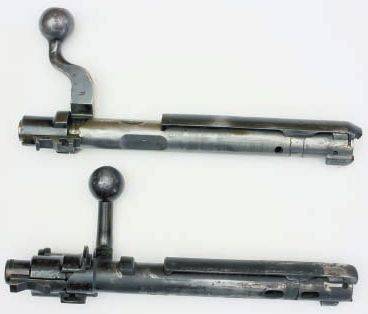
The Enfield P14 shutter (above) almost completely copies the Mauser shutter. Visually, it is easily distinguished by the shape of the handle.
The fact is that the English bolt of the Lee Enfield rifle was perhaps the most "quick-firing" of all that existed on the magazine rifles, and this was caused by the very successful position of the bolt handle over the rear wall of the trigger guard. Thus, the right hand arrow made the shortest path from the trigger to the bolt handle. It was in order to preserve these optimal parameters, and I had to give an almost S-shape to the handle of a new, practically “Mauzerov” gate, structurally different from the Lee-Enfield gate. And, most importantly, the Enfield-Mauser shutter, while retaining all the positive qualities of the Mauser shutter (including the ability to use very powerful cartridges), has become much simpler - it consists of six parts, against nine at Mauser.
The similarity of the Mauser and Enfield-Mauser valves resulted in almost complete copying of the trigger mechanism, which is very simple and consisted of only five parts: the trigger, the trigger lever with the sear, and also the screw, the axis and the spring of the trigger.
The percussion mechanism was equipped with a safety device against the possibility of a shot when filing the next cartridge, which kept the drummer in the cocked position. The trigger mechanism is equipped with a safety lock against shots when the shutter is not closed and against self-opening. When the safety lever was turned on, the striking mechanism and the trigger mechanism were disconnected, and the possibility of opening the shutter was also excluded.
The safety lever, made in the form of a lever, is located in the rear part of the receiver on the right, behind the shutter lever, which made it convenient to operate it with the thumb of the right hand without changing the grip and butt of the weapon.
The weapon was supplied with ammunition from an integrated box magazine with 5 capacity for cartridges with their chess arrangement. Equipment shop was carried out with the help of special plate clips or one cartridge at the open gate.
Apparently, the English 10-charging shop with a chessboard arrangement of flange cartridges, although it gave tangible advantages in the rate of fire, did not quite satisfy the military in terms of the reliability of sending cartridges to the chamber, and the dimensions of the weapon increased. So I had to slightly reduce the practical rate of fire in favor of the overall reliability of the weapon.
The store feeder had a slide lag that did not allow closing the bolt by using up all the cartridges from the magazine. The barrel of the 7,71 mm caliber had five grooves of the left direction. The stock was made of high-quality walnut and equipped with three swivels: one at the front ring, the other at the second ring, and the third under the butt.
The butt had a straight neck, in the back part turning into a weakly pronounced half-pistol grip. The back plate is brass, with a door covering the storage compartment. On the right, on the butt, a brass disk was attached, on which was indicated the designation of the unit (regiment) to which the rifle belonged.
In the groove of the forearm (under the barrel), longitudinal grooves are made to prevent the leads of the trunk, better cooling it and facilitate the forearm. The barrel pad, consisting of two parts, was fastened with two sliding rings. The front ring is one piece with the tip having a stop for the bayonet. Rompola rifle did not have. For cleaning and lubrication of the bore was used rope rubbing, worn in the butt.
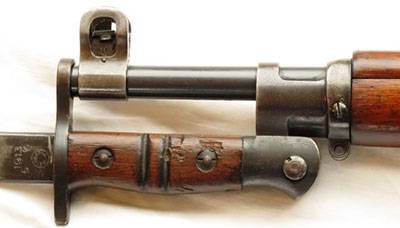
View of the mount bayonet Enfield P14
The bayonet with a blade in the form of a cleaver and a handle in a wooden frame was worn separately from the rifle, in special leather sheath. The rifle was equipped with two systems of sighting devices:
The first consisted of a ring sight and a fly. The sight, located on the rear of the receiver, with divisions from 200 to 1650 yards (182 - 1509 m), was not installed horizontally and was protected from external damage by the side walls of the block. The rectangular front sight, located at the muzzle of the trunk, is protected from external damage by “wings”.
The second one had a side sight attached to the left side of the weapon for salvo shooting at group targets and included a folding diopter rear sight, located on the left side of the main sight, and an adjustable fly in sight. The lateral front sight had divisions for firing from 1500 to 2600 yards (1372 - 2377 m).
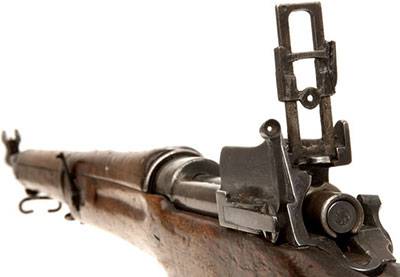
Enfield P14 (Rifle No.3). Sights
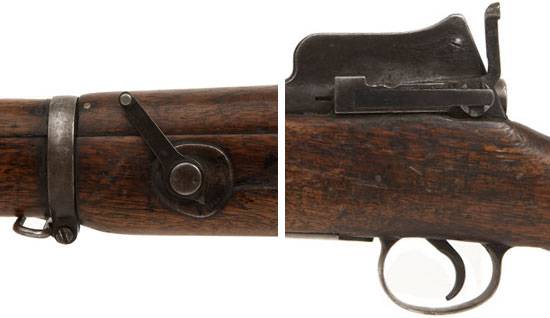
Sights Enfield P14 for salvo shooting at group targets
Enfield P14 performance characteristics
Caliber, mm .303 (7,7х56R)
Length, mm 1175
Barrel length, mm 660
Weight unloaded, kg 4,25
Magazine capacity, cartridges 5
Initial bullet speed, m / s 725
Aiming range, m 182 - 1509; 1372 - 2377
Effective range, m 800
4. Production and military service.
Oddly enough, but in England the rifle was never made. When Enfield P14 was ready for mass production, World War I began. The factory capacity for Enfield P14 simply did not exist, since all forces were thrown into the production of SMLE rifles, which were sorely lacking, with the result that the order for the production of new rifles of the .303 caliber was placed in the USA at the Winchester and Remington factories and Eddystone (a division of Remington).
During production, problems arose with the interchangeability of parts. Therefore, the letters appeared in the marking, which indicated the manufacturer of the weapon "Rifle, Magazine, .303, Pattern 1914, Mk IW", "Rifle, Magazine, .303, Pattern 1914, Mk IR", "Rifle, Magazine, .303, Pattern 1914, Mk IE ”(where W is Winchester, R is Remington, E is Eddystone).
Between 1915 and 1917, more than Enfield P1.200.000 14 rifles were produced year. This weapon was a fairly accurate rifle and much cheaper to produce than the SMLE. During the First World War, Enfield P14 was often used by British snipers, who appreciated its high accuracy.
However, in the English army, this rifle is not widely spread. The experience of the battles showed that well-trained English soldiers were excellent at using SMLE Mk.III rifles, which, in turn, did not confirm the worst expectations expressed, moreover, the rifles were undoubtedly successful and popular among the troops.
Before the Second World War, the model Enfield P14 remained in service, but in storage. Many rifles were transferred to the British dominions (Australia, Canada, New Zealand) and the Baltic countries. In the Second World War, it was used by the British militia and the army of the Philippine community. In 1947, this weapon was declared obsolete and completely decommissioned by the British Army.
In the 1917 year, when the United States entered the First World War, the supply of Р14 rifles to England was completed, and it turned out that now the Americans themselves are missing their regular Springfield M1903 rifles. Due to the limited capabilities of the US state arsenals producing M1903 rifles, it was decided to modify the Enfield P14 British rifle with the American .30-06 Springfield (7,62х63 mm) US unitary cartridge and place orders with the same manufacturers.
The new "Anglo-American" rifle received the official designation "United States Rifle, cal .30, Model of 1917" (Rifle of the United States, caliber .30, model 1917 of the year) or abbreviated as "US Rifle M1917". Later this weapon also became known with such unofficial names as “Pattern 1917”, “Pattern 17”, “P1917” and “P17”.
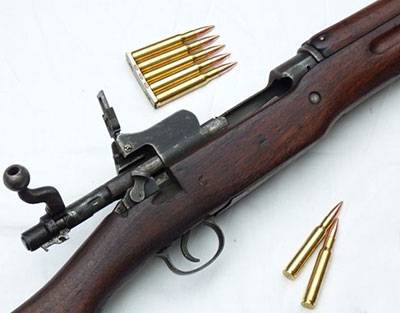
US Rifle M1917 with used ammunition
In terms of its design, the US rifle M1917 rifle was slightly different from its English prototype. In connection with the change of the English .303 British ammunition (7.7x56 R) to the American .30-06 Springfield cartridge (7,62х63), the bolt, magazine and barrel were slightly modified. The target range was reduced from 1650 to 1600 yards. In the American model, they completely abandoned the side sight for salvo shooting at group targets and removed a brass disk with the designation of a regiment on the right side of the butt.
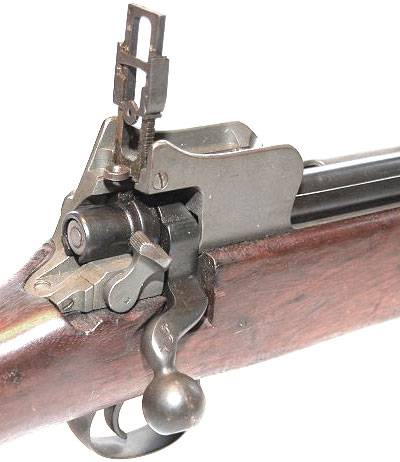
Sight US Rifle M1917
The production of US rifle M1917 was continued at the same weapons factories that the Enfield P14 British models had previously supplied. During 1917-1918, Winchester, Remington and Eddystone enterprises produced over 2270000 rifles (Winchester - 545511, Remington - 545541, Eddiston - 1181908). By November 1918, about 75% of US Expeditionary Forces soldiers who took part in World War I used M1917.
Immediately after the war, the question of choosing it as the main rifle of the American army was considered. Many soldiers appreciated the accuracy and reliability of the rifle. However, despite the brilliant experience of use, she could not force out the US model Springfield M1903 in the US Army - the reason for this was both a persistent reluctance to accept the "British development" and the desire to preserve the production of military weapons in state arsenals, as US Rifle M1917 rifles were made private companies. A large number of rifles were decommissioned and transferred to warehouses or sold on the civilian market as an excess of military property.
Since the beginning of the Second World War (1939-1945 years), the US Rifle M1917 rifles were “re-preserved” and transferred to the UK. By the summer of 1940, 615000 units of these weapons were brought to England, and then 119000 rifles were added to them, which were used to arm the militia. The rifles transferred to the UK had an additional marking in the form of a red broad band on the butt — a similar label was made to make it easier to distinguish the Enfield P14 rifles using the .303 British ammunition (7,7Х56 R) from the US Rifle M1917 rifles that used the .30- ammunition that 06 Springfield (7,62x63).
During the war period in the United States, these weapons were in service with the chemical troops. Due to the shortage of the M1 Garand, gunners received part of the rifles who participated in the battles in North Africa. According to some reports, it also had the American soldiers of the rear forces after the landing in Normandy. Of the allies, the rifle was in service with the Philippine troops, after the defeat of which went to the Japanese units and partisans.
After World War II, the US Rifle M1917 rifle was shipped to Denmark and Norway, used during the Korean War (1950-1953) and in the early stages of the Vietnam War (1955-1975). In addition, these weapons were used in individual military conflicts in the Middle East and the African continent.
5. Rifle Sergeant York.
The story about the Enfield P14 rifle will not be complete, if not at least one example of its combat use. In this regard, the rifle with its owner was lucky to participate in one of the most famous combat episodes of the First World War.
As is known, the 26 of September of the 1918 of the year began the Mesa-Aragon offensive of the Entente on the positions of the German troops. A company of the 328 G battalion of the eighty-second division, known as the "All-American", which included previously unknown York serving no one, also participated in it.
The first battles in the Argon Forest were relatively easy. According to their results, York was promoted to Corporal. But 8 October 1918, a platoon of York, advancing in a narrow valley, was pressed by the fire of the German machine guns from three sides. It was rumored that an experienced machine gunner could “sign” a queue on a sandbag. Soldiers have often seen enemy fire mow down entire companies and battalions. It was necessary to do something - and as soon as possible. As the artillery support nearby, a single mortar was accidentally located, but no one could indicate its targets.
Therefore, a group of 17 people led by Sergeant Earley slightly retreated and moved to the left flank to destroy the machine guns from the rear. The soldiers moved quietly and very quickly, from bush to bush - until the enemy saw them. Thick bushes and steep hills contributed to the disguise. Soon the Americans seemed to have gone to the German rear. Suddenly, they saw a group of 15 – 20 Germans shouting “Comrade!” And raising their hands. It turned out to be the German headquarters, which did not expect the Americans at all. No one except the Major Commander was even armed.
The Americans were about to collect prisoners, when suddenly the German machine-gunners on the rock in front turned and opened fire. A sergeant and two corporals fell, stitched in bursts. Part of the surviving soldiers rushed to the prisoners, part rushed to seek shelter. York was in the open, about 25 meters from the machine gun nests. At this point, 17 of the 8 soldiers remained - six were killed, three were injured.
Formally, York became the commander. But in the noise of the battle there was no point in giving orders, so the corporal, lying on the ground, just started shooting all the Germans he had seen. At this distance, he, a hunter since childhood, simply could not miss. When the German officer and five soldiers rushed at York with bayonets, he in turn shot them from a pistol.
Then York found a surrendered German major. He told York that if he stopped killing the Germans, the major would order the rest of the soldiers to surrender. And so it happened - the major blew the whistle, and the Germans obeyed. Only one of the soldiers, surrendering, tried to throw a grenade at York, but missed.
During the battle, York killed more 20 Germans and forced 132 to surrender, including 3 officers. The Germans surrendered and 35 machine guns. The next day, 28 Germanic corpses were found at the site of the battle. York continued to fight in the first line until November 1, when he was recalled and received the rank of sergeant. After numerous checks and re-checks, the episode was fully confirmed.
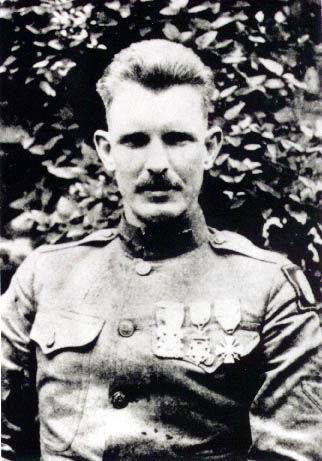
The sergeant became the most awarded soldier of the US Army, having received the Cross For Outstanding Merit, the Medal of Honor, the French Order of the Legion of Honor and many others.
Prepared by: Dekabrist
Sources:
BASIC FIELD MANUAL. US RIFLE, CALIBER .30 M1917 (ENFIELD). - GOVERNMENT PRINTING OFFICE, 1942.
F. de Haas "Bolt Action Rifles", 3th Edition, DBI Books, Krause Publications, Inc., Vernon Hills, IL, 1995, 528 pp
Kalashnikov №2, 2006
“Small arms of the Second World War. M. Popenker, M. Milchev. M., Yauza: Eksmo, 2014, 384
The site "Encyclopedia of weapons" http://weaponland.ru/
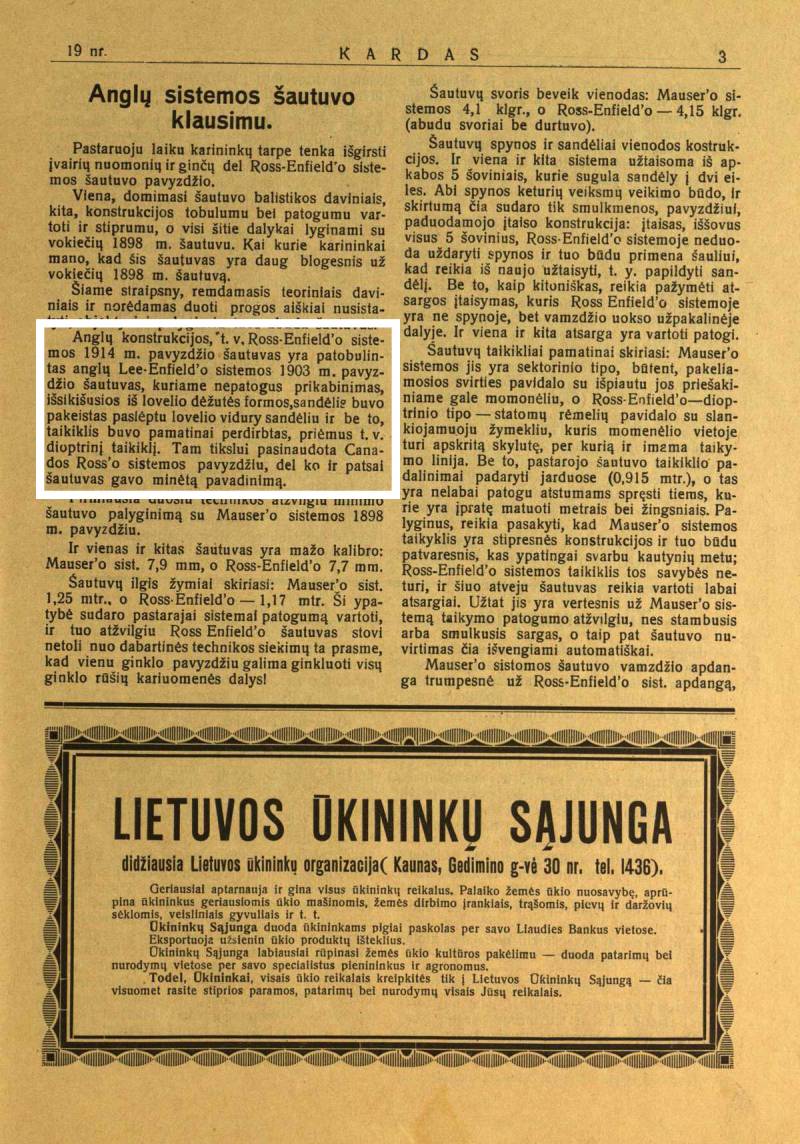

Information